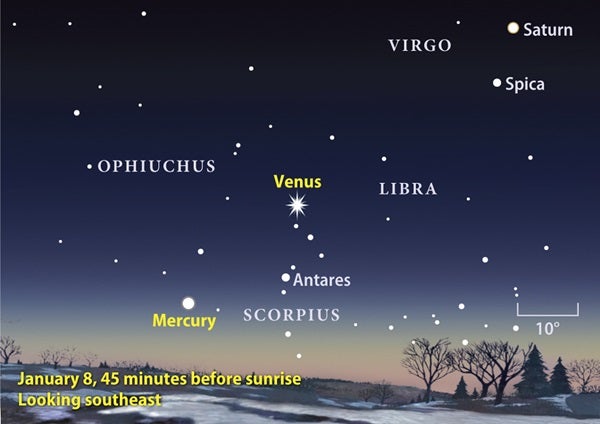If you head outside any clear morning this month, your eyes will be drawn to a dazzling light standing well above the southeastern horizon. At first you might think it’s a plane coming in for a landing. But this is no object flying low in our atmosphere — it’s the brightest planet in the solar system. Venus appears especially prominent in early January because it climbs to its highest point in the predawn sky.
Venus reaches greatest elongation January 8. On that morning, it lies 47° from the Sun, its maximum distance for this appearance. The planet rises more than 3 hours before the Sun and appears nearly a third of the way up in the southeastern sky 45 minutes before sunrise. But you won’t need directions to identify Venus — it shines nearly 100 times brighter than any other point of light in the morning sky.
“Venus now appears higher and brighter in the morning sky than at any time in more than 3 years,” says Astronomy magazine Senior Editor Michael E. Bakich. “You don’t want to miss this opportunity because it won’t be this high again until spring 2012.”
In a quirk of celestial geometry, Mercury reaches its greatest elongation from the Sun just a day after Venus. On January 9, the innermost planet lies 23° west of the Sun and appears 10° above the southeastern horizon 45 minutes before sunrise. Although it glows much more faintly than Venus, it will still be prominent to the lower left of its brighter cousin.
The morning sky also features the bright star Antares. Look for its ruddy glow directly below Venus and to Mercury’s upper right. Antares appears about one-third as bright as Mercury. If you have trouble seeing it with your naked eyes, binoculars will help you pick it out from the twilight glow.
Although naked eyes and binoculars offer the best views of the morning scene, anyone with a small telescope will get a thrill from targeting Venus. At greatest elongation, it looks like a miniature version of a First Quarter Moon, with one half in sunlight and the other half in darkness.
Fast facts:
- At greatest elongation January 8, Venus lies 62.6 million miles (100.8 million kilometers) from Earth and 66.8 million miles (107.5 million km) from the Sun.
- At greatest elongation January 9, Mercury lies 94.3 million miles (151.8 million kilometers) from Earth and 37.6 million miles (60.5 million km) from the Sun.
- Video: Easy-to-find objects in the 2010/11 winter sky, with Richard Talcott, senior editor
- StarDome: Locate Venus and Mercury in your early morning sky with our interactive star chart.
- Sign up for our free weekly e-mail newsletter.











